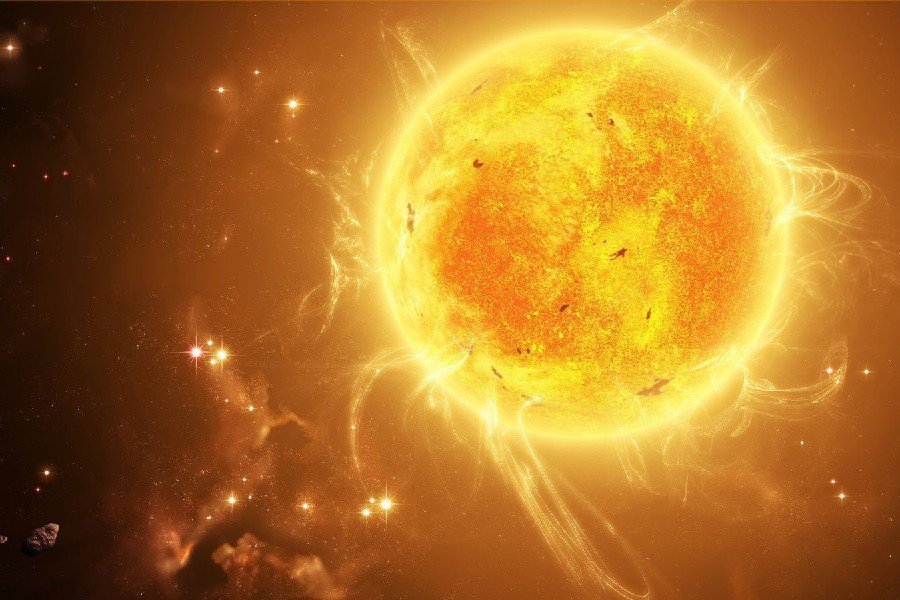Arcturus, a beacon in the night sky, stands as one of the most prominent stars visible from the northern hemisphere. Its brilliance captivates astronomers and stargazers alike, holding a significant place in the annals of astronomy. But what is Arcturus actually? How big is Arcturus?
Unraveling the mystery sheds light on the science behind the Arcturus sighting. We’ll explore connections from mythology to navigation methods that rely on Arcturus as a guidepost.
Delving into characteristics like color, temperature, size, and stage in the stellar life cycle begins to unravel the mystery of Arcturus. By the end of our journey, the radiant ruby-red glow of Arcturus may take on new significance.
Join us as we decode the illustrious Arcturus, often mythologized and hovering in the northern gates!

What Is Arcturus?
Arcturus is the fourth of the brightest stars we can see in the night sky without a telescope. It is part of the constellation Boötes and is known for its orange-red color.
It’s relatively closer to Earth than other stars, making it easy to spot on clear nights. People have been observing Arcturus for thousands of years. It has a special place in many cultures and myths around the world.
The brightest star
Arcturus shines as the brightest star in the northern spring and summer sky. Visible even to the naked eye, its vivid orange hue contrasts against the twilight backdrop. Ranking 4th among the brightest stars that can be seen from Earth, Arcturus outshines all but Vega and Capella north of the equator.
Arcturus luminosity is another reason why it stands out in the night sky. With around 113 times the luminosity of the Sun, Arcturus gives off an intrinsically bright light that allows its striking glow at over 36 light years distance to stand out distinctly to watchful observers.
This impressive stellar luminosity reveals itself without the need for optics. Simply a glance upwards in the dusk or dawn hours suffices. Viewers lucky enough to be positioned north of the equator experience this phenomenon on temperate spring and summer evenings.
Physical Characteristics
Arcturus possesses several standout physical characteristics. Starting with a giant radius of around 26 times that of the Sun, making it 262 times the Sun’s volume. With a roughly 1.1 times solar mass, this red giant packs over one solar mass into its outsized envelope.
But what is Arcturus surface temperature? Arcturus’ effective surface temperature also makes it unique, at around 10,000 degrees Fahrenheit. Cooler than many other red giants yet far hotter than our yellow-white Sun. Arcturus temperature lends it a striking ruby red color across the visible and infrared spectrum, in contrast to the Sun’s yellowish rays.
Together, attributes from its immense volume to its distinct reddish hue showcase it among the stellar class as a giant aglow in ruddy radiance. Exploring Arcturus’ singular properties allows us to put facts and measurements to an object only assumed familiar along the starry northern arc.
Distance from Earth
Arcturus lies 36.7 light years from Earth – over 209 trillion miles but near cosmic standards. It resides among the 10 closest stars, with only Alpha Centauri lying closer in our region of the galaxy. Brilliant Sirius sits farther away at 8.6 light years.
The proximity of Arcturus allows light emitted in the 1980s to arrive presently on Earth. At the same time, over 200 trillion miles separate us; its relative nearness places one of the night sky’s most illustrious gems in our galactic backyard.
Historical significance
Arcturus holds cross-cultural astronomical prominence. Ancient Asian traditions deemed it a royal celestial body, and navigating sailors named it the “Bear Watcher”. Also, it is home to mythic ancestors in some Native American lore.
Empirically, 17th century work documented Arcturus’ brightness and motion as spectral studies by 1900 showed it to be a red giant, not a main sequence star. Variable star designation followed from documented 20th-century emission fluctuations that maintain observatory intrigue to the present day.
Arcturus has captivated humanity across generations as an exceptional crimson sentinel in the night sky. Ancient folk histories unveiled Arcturus as an inspiring imagination tilted toward the heavens.
Modern telescope sights have continued highlighting Arcturus by providing ongoing empirical insights about its nature. Both mythic symbolism and scientific discovery illuminate this enduring red giant as a conspicuous jewel of the northern sky that sparks awe and curiosity age after age.

Classification of Arcturus
As an evolved K2.5-type orange giant that has exhausted hydrogen fuel after billions of years, Arcturus has cooled and substantially expanded from its main sequence incarnation, analogously resembling our Sun.
Having moved off the main sequence at the turnoff point, elderly Arcturus possesses a dense helium core resulting from additional fusion. Our still youthful Sun maintains core hydrogen fusion as a G2-type yellow star.
While the post-red giant branch ruddy Arcturus has significantly altered internal and external attributes over its long lifetime, it is approaching its core’s helium flash phase ignition.
Arcturus nears the next major evolutionary leap during a comparatively stable autumnal giant phase. Shining in redder radiance but slower burning following rowdier main sequence lifetime stages long concluded.
Categorized among K-class evolved stars no longer fusing hydrogen, orange sentinel Arcturus has distanced itself from cousins like our middle-aged Sun through billions of years of cooling. This process has magnified its reddish dimensions along destined stellar aging pathways.
Arcturus in the Night Sky
Arcturus shines prominently in Northern Hemisphere skies thanks to its bright visibility and signature red-orange color. But where is Arcturus and how to spot it in the night sky?
Blazing high at dusk in March-May around 40° North latitude, solitary Arcturus can be spotted by tracing the Big Dipper’s handle in an arc until this lone red giant comes into view.
As one of few stars bright enough to breach the celestial equator, Arcturus sinks only gradually each night into the summer sky. Its location and striking color contrast starkly against surrounding white and blue-tinted constellations like Boötes and Corona Borealis.
Historically essential for navigation when Polaris was obscured, Arcturus marked both the latitude for sailors and the position of Ursa Major. Additionally, its annual March rising signaled seasons from Earth’s orbital precession. Orange giant Arcturus persists as a beloved fixture circumscribing the Northern Hemisphere.
Conclusion
What is Arcturus? It is a prominent star in the Northern Hemisphere, known for its bright, reddish appearance. It is the fourth brightest star in the night sky and belongs to the constellation Boötes.
As we draw these explorations to a close, meandering through some astronomical revelations and intriguing Arcturus facts has opened new perspectives. We’ve touched on navigational lore and a potential exoplanetary environment awash in ruby hues.
Our scientific understanding of Arcturus has evolved significantly. We now comprehend its spectral class and oxygen fusion processes. When we next observe its arc, we can gaze with newfound knowledge. This stellar signpost holds deeper secrets than we previously realized.
